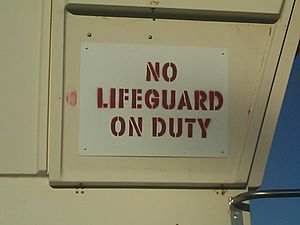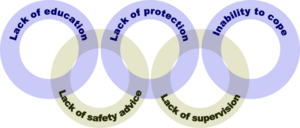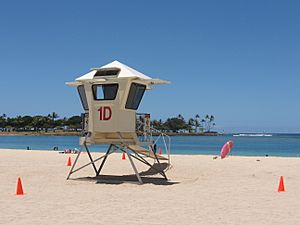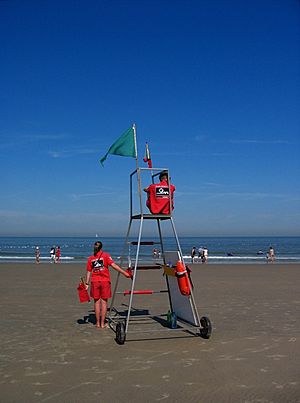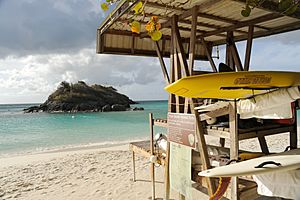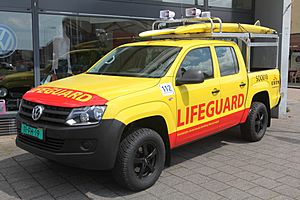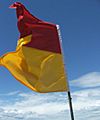Lifeguard facts for kids

A lifeguard is a person who helps keep people safe in and around water. They work at places like beaches, public pools, and lakes. Lifeguards teach people how to use water facilities safely and work to prevent accidents. They are also highly trained to perform rescues if someone gets into trouble.
Contents
What Lifeguards Do
Keeping People Safe
A lifeguard's main job is to make sure everyone stays safe in their assigned water area. This area often includes the space right next to the water, like a beach or pool deck. Their top goal is to prevent any harm from coming to people using the area. Lifeguards can be paid employees or volunteers.
To prevent drowning, lifeguards follow a plan based on the 'drowning chain'. This chain shows how accidents can happen. It includes things like not knowing water safety rules, not getting safety advice (like about strong currents), not having safety gear (like a life vest), not having supervision, or not being able to handle water conditions (like big waves).
The 'drowning chain' helps lifeguards prevent accidents by focusing on:
- Teaching people about water safety.
- Giving warnings about dangers.
- Blocking access to unsafe areas.
- Watching people carefully.
- Teaching survival skills.
Lifeguards use all these methods to stop accidents before they happen. It's always better to prevent an incident than to react to one. This means a good lifeguard team isn't just measured by how many rescues they make, but by how few drownings or accidents occur. Prevention is a super important skill for any lifeguard.
Daily Duties
Lifeguards, often working in teams, have several key duties:
- They make sure people follow rules to prevent problems and injuries.
- They watch their assigned area and the people in it very closely. This helps them spot problems early and step in to prevent a drowning.
- They supervise other equipment, like water slides, if that's part of their job.
- They perform rescues and start other emergency actions when needed.
- They give immediate first aid if someone gets hurt or has a medical problem.
- They talk to swimmers and other visitors to help with safety.
- They might help clean areas around the pool or beach to keep it safe and enjoyable.
Sometimes, lifeguards have other tasks like cleaning, filling out forms, or checking pool chemicals. But their main job is always keeping people safe. They must never let other duties get in the way of watching the water. Lifeguards also attend regular training to keep their skills sharp.
Lifeguard Training
Lifeguards learn many different lifesaving skills. The exact skills can vary based on the training organization and the type of water facility. For example, training for a shallow pool is different from training for a deep pool, a water park, or a beach.
Some important skills learned for land-based situations include:
- Cardiopulmonary Resuscitation (CPR): This involves chest pushes and rescue breaths to help blood flow with oxygen to vital organs. Lifeguards learn how to do CPR for adults, children, and infants. For adults and children, they use two hands on the chest, pushing about 2-3 inches deep. For infants, they use two fingers, pushing about 1.5 inches deep. The rhythm is usually 30 pushes for every 2 breaths.
- Using an AED (Automated External Defibrillator): An AED is a device that gives an electric shock to help restart a normal heart rhythm. Lifeguards learn where to place the pads on adults, children, and infants.
- First Aid: Lifeguards learn how to protect themselves from blood-borne germs by wearing gloves and using a pocket mask during CPR. They also learn how to treat many different injuries and sudden illnesses.
- Emergency Oxygen Administration: This involves giving extra oxygen to people who are having trouble breathing or have heart problems.
- In-Line Stabilization: This technique is used for suspected head, neck, or spinal injuries. Lifeguards use their arms to keep the head still and prevent more movement.
- Helping Someone Choking: Lifeguards learn how to help conscious and unconscious adults, children, and infants who are choking. For conscious adults and children, they use five back blows and five abdominal thrusts.
Some important skills learned for in-water situations include:
- Active-Victim Rescue: This is a simple rescue to move someone who is actively drowning to safety.
- Passive-Victim Rescue: This involves rescuing and removing someone from the water who is not moving. There are different ways to do this for shallow and deep water.
- Spinal Rescue: This rescue is used when a victim might have a head, neck, or spinal injury. Lifeguards use special methods to avoid moving the victim too much, which could cause more harm.
How Lifeguards Enter the Water
Lifeguards use different ways to get into the water, depending on the situation:
- Slide-in Entry: This is the slowest entry. It's used when a victim might have a head, neck, or spinal injury, to avoid making the injury worse.
- Stride Jump: This is used in water that is at least five feet deep. The lifeguard should not be more than three feet above the water.
- Compact Jump: This can be used from the side of the pool or from a lifeguard chair. The water must be at least five feet deep if jumping from a higher spot.
- Run-and-Swim Entry: This is used in shallow water that gradually gets deeper, from zero depth to at least three feet.
These entries are chosen based on whether the victim is moving or not, how deep the water is, and if there's a possible head, neck, or spinal injury.
Where Lifeguards Work
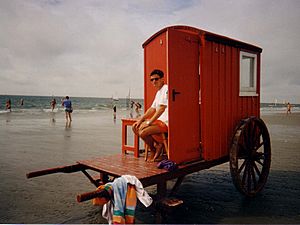
Lifeguards work in many different water environments, each with its own challenges:
- Ocean Beaches: Lifeguards are often seen on ocean beaches. This can be the hardest place to work because of changing weather, strong currents, tides, and waves. Beach lifeguards need to be in excellent physical shape.
- Inland Water (Waterfront): Lifeguards also watch over open water areas like rivers, lakes, or ponds where people swim.
- Swimming Pools: Most large pools, both indoors and outdoors, are required by law to have lifeguards.
- Water Parks: These are like swimming pools but have extra features such as water slides or wave machines.
- Ocean Lagoons or Tidal Pools: These are enclosed areas of seawater. They are like pools but can have extra dangers beyond what you'd find in an artificial pool.
- Open Ocean: Sometimes, lifeguards are hired for safety when people swim in the open ocean from a boat, like a cruise ship.
Where Lifeguards Sit or Stand
Lifeguards need to have the best possible view of the area they are watching. They often do this from a high spot, like a chair, platform, or even the roof of a vehicle. Being elevated helps them see everything clearly and communicate with their team.
Some lifeguard teams use chairs or platforms that can be moved. This is helpful if the water conditions change, like the tide going out on a beach, or if there's a special activity happening.
The lifeguard chair or tower also acts as a storage spot for important rescue and communication equipment. It's also a clear place for people to find help. Often, flags are flown from these spots to show where the lifeguards are and to give information about swimming conditions.
Depending on the location, lifeguards might also patrol the water's edge on foot. This allows them to talk directly with people and offer advice. In large open water areas like the sea or big water parks, lifeguards might use boats or other personal watercraft to patrol on the water. This helps them cover more ground and respond faster to emergencies.
The 10:20 System
The 10:20 system is a special technique lifeguards learn. It means a lifeguard should be able to scan their entire area (like a pool) in 10 seconds. Also, they should be no more than 20 seconds away from any swimmer who might get into trouble in their area. This system helps ensure quick response times.
Lifeguard Equipment
Lifeguards use different equipment depending on where they work and the conditions. However, some items are always important:
- A whistle to get people's attention or signal to other lifeguards.
- A first aid kit.
- Rescue aids like rescue cans, rescue tubes, and rescue boards.
- Other equipment can include spinal boards, AEDs, trauma bags, and oxygen tanks.
Rescue Tools
Lifeguards follow a set of steps for rescues that keeps them as safe as possible while helping others. They always try to help from a distance first. They might use a long pole, throw a lifebuoy, or wade into the water. If needed, they use watercraft or swim with a rescue aid like a rescue buoy. Swimming directly to a victim is usually a last resort.
Some lifeguard teams also have special training in things like scuba diving or swift water rescue. They will carry the right equipment for these advanced skills.
First Aid Gear
Lifeguards are very good at first aid and have well-stocked first aid kits. They might also have advanced items like extra oxygen, a suction device, a resuscitator, an AED, or a spinal immobilization board. Lifeguards are trained to call emergency medical services (EMS) right away if someone needs serious medical help.
Rescue Boats
Sometimes, lifeguards use inflatable motor boats. These are helpful for reaching victims who are far away or when there are big waves.
Communication Tools
Good communication is super important for lifeguards. They use whistles, two-way radios, megaphones, or even signal flares.
A traditional way to talk to the public is by using colored flags. These flags are raised on poles to tell people important information, like if it's safe to swim.
In pools, lifeguards often use whistles with specific signals:
- One short blast: To get a swimmer's attention.
- Two short blasts: To get the attention of other lifeguards or supervisors.
- Three short blasts: To show that a lifeguard is taking action in their area.
- One long blast: (In swimming pools) To clear the pool. Also used to signal to another lifeguard that you are going in for a rescue.
- Two long blasts: To tell swimmers they must leave the pool, perhaps because it's closing or there's a big emergency.
Transportation
For large areas like beaches or lakes, lifeguards might need vehicles to get around. They use land vehicles like pick-up trucks, quad bikes, or other off-road vehicles.
They might also use larger water vehicles such as rigid or inflatable boats, personal watercraft, or even hovercrafts.
Images for kids
-
A lifeguard on patrol during Hurricane Earl.
-
Two lifeguards of the German DLRG patrolling a public bathing area of a lake on stand-up paddleboards in Munich
-
Lifeguard tower with yellow and purple flag in Miami Beach
-
Lifeguard tower, Asprovalta (Greece)
-
Sign in Bray, Ireland explaining lifeguard flags.
-
Lifeguard in Barcelona
-
Lifeguard pick-up truck of the RNLI
-
Lifeguard tower and truck in Ocean Beach, San Diego, California
See also
 In Spanish: Socorrista acuático para niños
In Spanish: Socorrista acuático para niños


